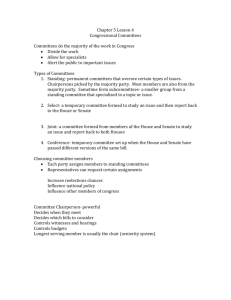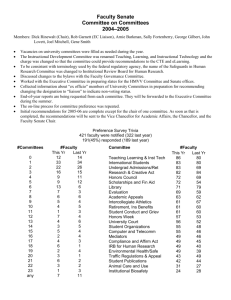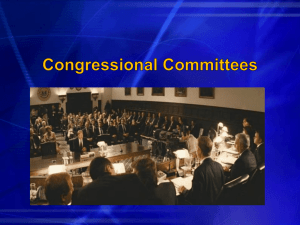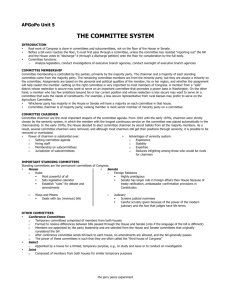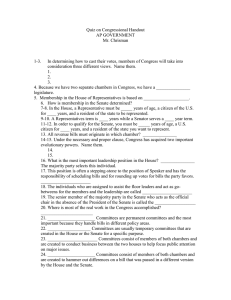Leadership in Congress and the Committee System
advertisement
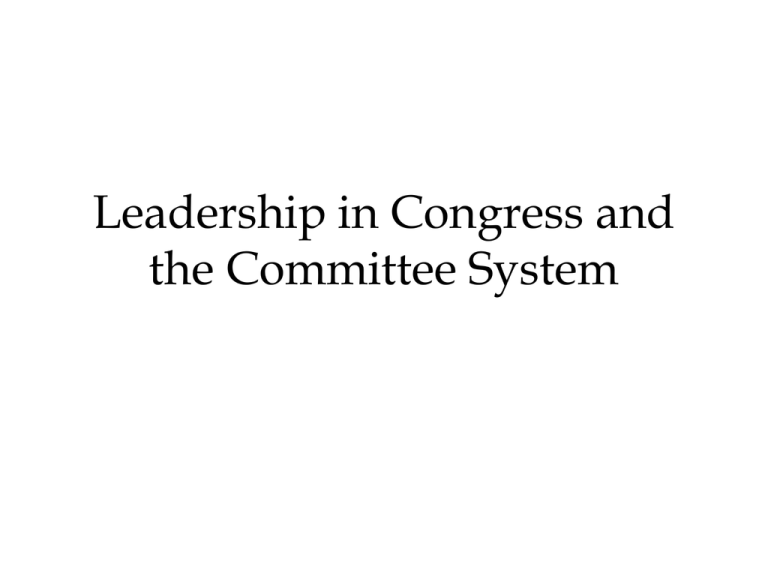
Leadership in Congress and the Committee System • House of Representatives • Speaker of the House • 1. Presides over the House. • 2. Appoints select committees (temporary and for specific purpose), and conference committees (joint – reconcile House and Senate versions of a bill). • 3. Appoints Rules Committee members and its chairman (Reviews all bills). • 4. Assigns bills to committees. • 5. Second in line for presidency after V.P. • Majority Leader and Minority Leader • 1. Partisan positions chosen by party members. • 2. They are the floor leaders and legislative strategists. • • • • • Majority Whip and Minority Whip 1. Assistant floor leaders. 2. Inform party leaders on “mood” of the House. 3. Keep nose count on important votes. 4. Persuade party members to vote with party. • Senate Leadership • • • • • Vice President 1. President of the Senate. 2. Presides over the Senate. 3. Votes in case of ties. 4. Ceremonial job • • • • President Pro Tempore 1. Ceremonial job. 2. Presides when V.P. is absent. 3. Third in line for presidency. • • • • • • Majority Leader 1. True leader in the Senate. 2. Recognized first for all debates. 3. True leader of majority party. 4. Influences committee assignments of senators. 5. Influences Senate agenda, along with Minority Leader. • Minority Leader and Party Whips: • (Same as in the House) • The Committee System • The real work of congress is done in committees and subcommittees, not on the floor of the House or Senate. • Before a bill even reaches the floor, it must first pass through a committee, unless the committee has resisted “reporting out” the bill and the house votes to “discharge” it onto the floor for consideration by the full body. (Senate committees lack power to prevent bills from reaching the floor). • Committee functions: • 1. Handle legislation. • 2. Conduct investigations of executive branch on asneeded basis. • 3. Conduct oversight of executive branch agencies on an ongoing basis. • Selection of committee members. • A. Importance of getting on the right committee, the one in which a member can best serve his constituents, and thus increase chances of reelection. • B. Members are assigned to committees by either the Committee on Committees (used by Republicans), or the Steering Committee (used by Democrats). • C. Whichever party has a majority in the house will have a majority on each committee. • • • • • • • Selection of Committee Chairmen A. Power of chairmen is substantial: 1. Setting committee agenda. 2. Hiring staff. 3. Membership on subcommittees. 4. Jurisdiction of subcommittees. B. Chairmen are selected by secret ballot in party caucuses or conferences (of party leaders) at the beginning of each term. Generally, seniority system is followed (person of majority party on committee w. most seniority gets job). 104th Congress imposed 6-year term limits on chairmen (2001). • • • • • C. Advantages of seniority system: 1. Experience. 2. Stability. 3. Expertise. 4. Reduces infighting among those who would be rivals for chairmen. • D. Disadvantages of seniority system: • 1. Conservative/status quo bias. • 2. Other ideas??? • Don’t forget: Decentralization of the 1970’s and lots of reforms (previous lecture). • Standing Committees: Permanent committees. Have both legislative and oversight powers. • House: • 1. Rules: most powerful of all. Sets legislative calendar and establishes “rules” for debate and amendments. • 2. Ways and Means: deals with tax bills. • 3. Appropriations: deals with spending bills. Authorization bill allows for money to be spent, and appropriation bill provides the actual funding for the program. • 4. Budget. • 5. Armed Services. • Senate Standing Committees • • • • 1. Finance – tax bills. 2. Appropriations – spending bills. 3. Budget 4. Foreign Relations – Highly prestigious. Senate has larger role in foreign affairs than House because of ratification and ambassador confirmation provisions in the Constitution. • Last slide, I promise… • Conference Committees • A. Temporary committees comprised of members from both houses. • B. Develop compromise language on a bill when House and Senate versions differ. • C. After the conference committee sends a bill back to each house, no amendments are allowed, and the bill generally passes. • D. The power of these committees is such that they are often called the “third house of Congress.” • Other types of committees • A. Select: appointed by a house for a limited, temporary purpose. • B. Joint: composed of members from both houses for similar temporary purposes.


